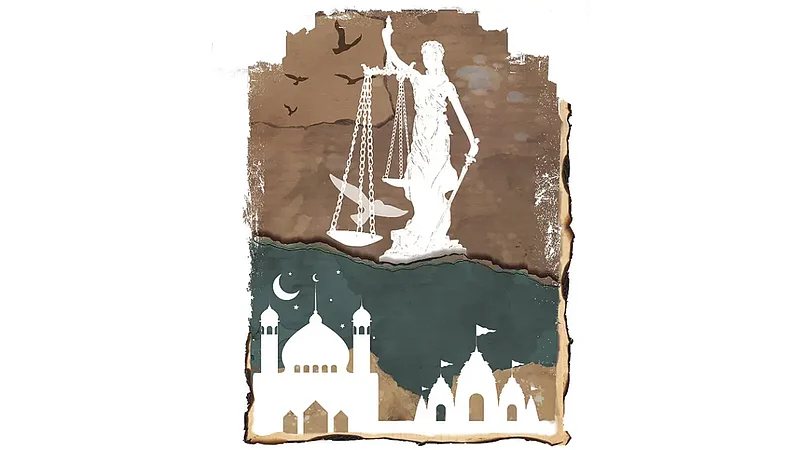The Places of Worship (Special Provisions) Act was enacted by the Indian government in 1991. It sought to prohibit the conversion, and to ensure the maintenance, of the religious character of all places of worship, as it existed on August, 15, 1947. The reason behind choosing this cut-off date was, in the words of Dr Malini Bhattacharya, Member of Parliament, it was the day India achieved independence and emerged as a democratic and sovereign State; a State that has no official religion and gives equal rights to all religious denominations.
Before the Places of Worship Act was tabled in the Indian Parliament by the Union Government, MP from Jangipur, West Bengal, Zainal Abedin, on July 12, 1991, introduced before the Lok Sabha a resolution titled ‘Steps for Maintaining Status Quo of Religious Shrines and Places of Worship’ as they existed on August 15, 1947. The resolution aimed to urge the government to peacefully settle the Ayodhya dispute and enact suitable laws for the preservation of all religious shrines. However, MP Abedin withdrew his resolution on August 23, 1991, the day a government bill on similar lines was introduced before the Lok Sabha by the then Union minister of home affairs, S.B. Chavan, which received the assent of the majority on September 10, 1991. Subsequently, it was adopted by the Rajya Sabha on September 12, 1991, and received the President of India’s assent on September 18, 1991.
The law and the exceptions
The law was enacted to prohibit the conversion or alteration of any place of worship, or religious character of any faith. To regulate this, any person who does the contrary will be imprisoned for a term extendable up to three years, with a fine. The law also seeks to impose a positive obligation to maintain the religious character of every place of worship. To achieve this, the Act provides for the abatement of all allied legal proceedings and even bars the institution of a fresh suit or appeal with respect to the conversion of any place of worship. The only exception to this rule is if a proceeding was instituted before the commencement of the act on the grounds that the conversion had taken place after August 15, 1947, as only then such suits, appeals or legal proceedings shall be adjudicated by the court of law.
However, there are two exceptions to the Act. First, this law does not apply to the conversion of any religious place that has been effected or settled by the parties concerned themselves before the commencement of the Places of Worship Act i.e. before September 18, 1991. Second, the law uniquely exempted the Ram Janmabhoomi-Babri Masjid dispute at Ayodhya from its application. This exception was carved because when the law was enacted, the Ayodhya dispute was already under legal scrutiny. It was finally settled by a five-judge SC bench on November 9, 2019.
Defining a place of worship
The law defines a place of worship as a temple, mosque, gurdwara, church, monastery or any other place of public religious worship of any religious denomination or any section. The expression has been defined in the broadest terms to cover places of public religious worship of all religions and denominations. While this expression is used in many Union and state laws, none of these define ‘place of worship’ using a set of specific or objective criteria.
The Supreme Court, in a series of its landmark judgments, has laid down specific criteria to be met for a religious denomination or practice to be recognised under law and to be afforded the fundamental protections provided by the Indian Constitution. For instance, a religious denomination or sect needs a common faith, an organisation and a distinctive name for it to be recognised. Similarly, only those practices and rituals that pass the ‘essentiality test’—i.e. they form an integral part of the religion—can be protected under the Constitution. No such indicators have been laid down for the recognition of a place of worship and its scope continues to be an extensive one.
While the law has a broad definition of what is considered as a place of worship, the act carves out an exception that it does not apply to a religious place that is an ancient/historical or archaeological monument, site or remains under the Ancient Monuments and Archaeological Sites and Remains Act, 1958. Such a place will not fall within the ambit of the Places of Worship Act. However, the provisions for maintenance and preservation of monuments under the 1958 act will apply to these historical and protected religious sites.
Law’s anomaly
The 1991 act was enacted to safeguard places of worship amidst the rise in communal violence, but has been disputed at several instances for its ambiguity and contradictions. For instance, the law requires no fresh suit to be instituted that is related to the conversion of a place of worship, but a situation having a disputed place of worship or religious character of an establishment would require the timely intervention of courts for a peaceful resolution. By not providing a forum and method for adjudication, the law recklessly leaves the matter unattended, opening doors for complex outcomes.
The law is also not in harmony with the prevalent construction practices as in cases where, for infrastructural development or highway expansions, certain places of worship are often even shifted after consulting the local authorities and communities as a standard practice. But a blanket embargo under the act makes this prevalent practice a criminal offence, which is unsound. Laws in major jurisdictions like the UK, do allow for certain alterations of their religious places if extenuating circumstances require them to do so, but only after preparing a detailed project report and getting an express approval from local authorities.
The Places of Worship Act came at a time when communal disharmony was on the rise. It intended to affirm India’s secular values by protecting religious shrines. While the law’s objective of discouraging any retrogression into communal fault lines is admirable, its contradictions and ambiguity on many counts have rendered it inefficacious. A comprehensive refurbishment of the act by addressing the paradoxes, defining the scope and bringing the law in harmony with the standard legal procedures and practices is vital for it to fulfil its aspirations.
(This appeared in the print edition as "Lost in Ambiguity")
(Views expressed are personal)
Arindam Bharadwaj is a lawyer and a lecturer at University of East London





















